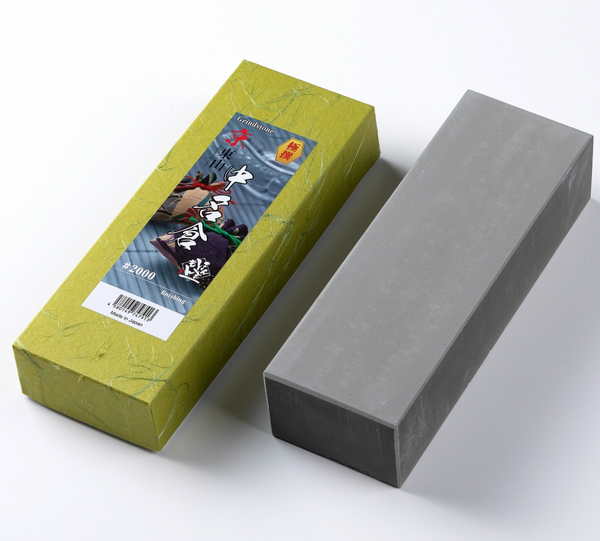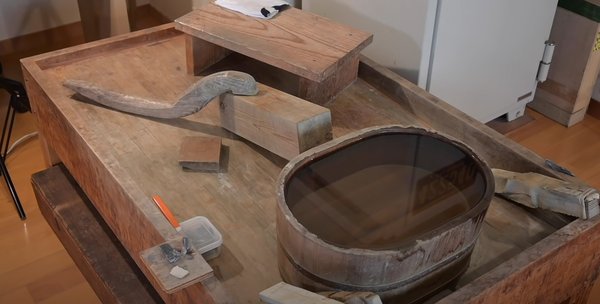How to Sharpen a Katana?
How to Sharpen a Katana?
Each authentic Katana has a rich and intriguing background, making them highly sought after by collectors. These rare and exquisite swords can cost thousands or even millions of dollars since they are an integral element of Japanese culture. The legend of Katanas is known by many. However, how to sharpen a katana is not something most are familiar with.
In Japan, sharpening something is called "Togi" (研), and craftsman who polishes blades is called "Togishi" (研師). It's an aesthetic and spiritual endeavor that might take weeks, even when carried out by a master artisan. While this polishing method is commonly used to sharpen the edge of a blade, it also helps to reduce the appearance of cracks and highlight the blade's hamon line.
Now many people take up the hobby of collecting Japanese Katanas, even customize their own katana. But eventually, the edge of any blade will dull and need to be sharpened. No doubt, sharpening a Katana may be a scary task at first, but with experience, you'll get used to it. If you love collecting Katanas and wish to learn to sharpen them, keep reading to learn seven easy steps to sharpen a Katana!

Table of Content
- Sharpen your katana the traditional way
- Steps to Sharpen Your Katana
- Sharpen your katana the Modern way
Sharpen your katana the traditional way
It might sound super boring, but sharpening a katana in traditional way could give you a sense of accomplishment and mastery as you see the blade becoming sharper and more refined with your own efforts. Don't think only super expensive nihonto deserves the time and effort, your practice katana also should be rewarded.
It’s a process that requires patience and precision, and successfully doing it can give you a deeper appreciation for the art of swordsmanship. Here are the things you need for traditional katana sharpening –
1. Whetstone (砥石 Toishi)

The first material you will need on hand is whetstones or sharpening stones. These tools are widely used to sharpen or polish the blade of a katana. Many stones are available, but you will want the flat stone for your Katana. Whetstones with grit between 1000 and 1500 are best for sharpening Katana swords.
In addition to genuine Japanese whetstones, you can also find synthetic versions with varying grit levels for sharpening your blades. However, the price of such stones is typically more than that of standard whetstones.
2. Grit Sandpaper
You can get the best results sharpening your Katana on a piece of 3M emery cloth sandpaper. It is designed to remove rust and corrosion from metals before sanding them. This kind of cloth won't rip or tear the premium stainless steel.
3. Oil or Clean Water
Japanese water stones will eventually wear down from repeated use, which is natural and necessary for maintaining a sharp edge. That's why it's essential always to have water around, as it will save your life by preventing you from constantly searching for it. In addition, we advise loading up a water bottle to use as a spray. You'll always be able to spray water when you need it.
Even though water often suffices, oil is the ideal choice for sharpening Katana swords. The 3-in-1 oil is the best option for you. Most shops that sell weapons or metal hardware will carry this oil. Vegetable oil is widely available, but you shouldn't use it despite the temptation.
4. A Board or Tabletop Work Comfortably
When you sharpen your Katana, you will need a stable surface to hold it. Use a wooden board, work desk, or dedicated sword stand; any flat and level surface would do.
If you're sharpening or scraping a blade, be sure the edge rests on one side of the surface. A simple wooden board may suffice in some situations.
5. Wiping/Gripping Fabric
You may use just about any fabric. The blade of the Katana can be made smoother and cleaner with the help of cloth. It may not seem like much, but a piece of cloth is the only tool you'll need to sharpen your Katana properly.
Keep an extra dry towel on hand to grip the Katana as you hone it. It will lessen the likelihood that you'll damage yourself.
Steps to Sharpen Your Katana
If you want to know how to sharpen your Katana at home, there are a few strategies you can employ. Still, it’s always recommended to have your blade sharpened by a professional. If you plan to learn and do it yourself, be well prepared, as it will take a long time to finish this procedure.
Step 1: Get Your Workspace Ready

*Photo: A traditional Japanese katana polishing set up (source)
Look for a neat, well-lit, and spacious place to work in peace. Get to a place where you won't be disturbed and can concentrate peacefully.
Set up a solid base, like a wooden block or a sword stand, to keep the Katana in place. You're handling a razor-sharp blade; any slip-up or diversion might easily cost you a finger.
Step 2: Remove the Tsuka

Unless your katana is stored in shirasaya (likely only for expensive blades), it's advised to remove the tsuka before sharpening. It's not complicated, you can use a tiny hammer and a stick to gently push the Mekugi (peg) out of the Tsuka. then you can pull out (might take some effort) and place the Tsuka aside. Put the Mekugi in the hole of the Tsuka in case you lost it.
Remember, you don't need to unwrap the ito wrap, after you finish sharpen the katana you can still easily assemble the sword.
Step 3: Clean the Blade

Check the blade for severe nicks, chips, or other damage. Avoid sharpening if there are serious problems; instead, have them fixed by a professional.
If there's no issue, use a thick towel to gently wipe the sword clean of any oil, residue, or dirt that may have accumulated since the last time you sharpened the blade. Gently slide the cloth along the edge without applying any pressure. You won't have to worry about accidentally cutting yourself.
Step 4: Choose the Appropriate Whetstone and Soak It in Water
Your sharpening needs will determine the grit level of the whetstone or Waterstone you should use. Finer grits, with 3000 or more, are ideal for honing and polishing the edge. Coarser grits, such as 1000 or lower, can eliminate nicks or reshape the blade.
To soak the whetstone, put it in water. The typical soak time for a whetstone is 15–20 minutes. The sharpening surface will be significantly safer for the fragile Katana. You may now begin the process of sharpening.
*Important Tip: You could also add some baking soda in the water to prevent the blade from rusting. Katana blade is usually with high carbon content and get rusting faster than you thought, so the changes PH of the water and will slow down the rusting significantly.
Step 5: Start Sharpen Your Katana

The goal here is the sharpen the edge, during the process, you should be very careful not be damage the other part of the blade, especially don't ruin the hamon line. Your sharpen moves should focus on the edge line.
Set the Katana down on its side, tang-side up. To determine the optimal sharpening angle, raise the spine ever-so-slightly. Keep the edge and stone at a constant 10-15 degree angle. Put your hand on the cloth-wrapped tang and your other hand on the blade's spine for a secure grip. To get the most out of each stroke, draw the blade across the stone at an angle as you press it into it.
Repeat the process after putting the edge back. Put a pressure of about 4 to 6 pounds of force on the whetstone when sharpening your Katana. Do 3-5 sweeps on each side. Choose the left or right side to begin. Perform the same number of passes on the other side. After some time, your muscle memory should adapt as you continue practicing. But you can also use a honing guide for help.
Tips:Use Oil or Water
While honing your Katana, don't forget to maintain the water and oil on the whetstone. Whether you should use water or sharpening oil depends on the material you use for the process.
The lubricant keeps the sharpening process cool by lowering the friction between the tools. Spread the liquid medium on the whetstone. After every third pass, treat the stone with water or oil.
How long does it takes to sharpen a katana?
The time you need depends on the sharpness level you want to achieve, the sharpen process usually takes anywhere from 5-10 minutes, to hours, even days. If the katana wasn't too dull to begin, a skilled person could sharpen it to paper cutting sharpness in less than 10 minutes.
Step 6: Blend the Edge
You don't have to do this; in fact, very few people do. Now that you've sharpened your blade to a razor's edge, you may smooth off any rough spots using a piece of sandpaper.
After you've finished sharpening and polishing the blade to your satisfaction, wash it off with a clean towel to remove any residue or stray metal particles.
Step 7: Test the Sharpness
After sharpening, you should perform a paper cut test. Doing so lets you assess the blade's current sharpness and determine whether it needs further honing.
You may use any ordinary paper sheet by letting the Katana fall on it. If your blade can cleanly slice through the paper, it is sharp.
Katana is a great weapon but it doesn't cut everything, make sure your sharpness test don't go too far.
Sharpen your katana the Modern way

Sand belt makes sharpen much easier, in fact, most budget katana you bought are sharpened by sand belt, because it is the fastest and cheapest way to get acceptable sharpness for the edge. Sharpening katana using sand belt machine is similar to whetstone, keep the edge at a constant 10-15 degree angle against the belt, you will get a razor sharp edge in seconds.
Tips: Control the temperature, sand belt is much faster and it will heat the blade, make sure you don't ruin the heat treatment of the blade.
Katana Sharpness Level
In ancient Japan, the way to test the edge sharpness is called "tameshigiri". The cutting test material is corpses of criminals, they will stack multiple bodies on a platform and test how many could be cut through with a single stroke. The result will be engraved on the nakago called Mei, this type of mei is called: Saidanmei (截断銘)
Katanas of exceptional sharpness were classified as "Wazamono. 業物" Based on tameshigiri performance, swordsmiths were ranked into four categories:
Saijō Ōwazamono 最上大業物 (Supreme Grade Wazamono): Top-tier category with 15 smiths known for crafting the sharpest swords.
Ōwazamono 大業物 (Great Wazamono): Second highest category with 21 smiths.
Ryōwazamono 良業物 (Good Wazamono): Third category including 58 smiths.
Wazamono 業物 (Wazamono): Fourth category with 93 smiths.
In addition, 68 other smiths known for various grades of Wazamono craftsmanship are also mentioned, totaling 255 smiths recognized for their skill in forging sharp swords.
Conclusion
The Japanese Katana has a curved blade with a single edge and is one of the world's most impressive and well-made blades. Now many collect Katana swords as a hobby, but maintaining their sharpness can seem daunting.
But don't worry; if you are searching for how to sharpen a Katana, I share seven easy steps in this article. Thanks for reading till now.





















